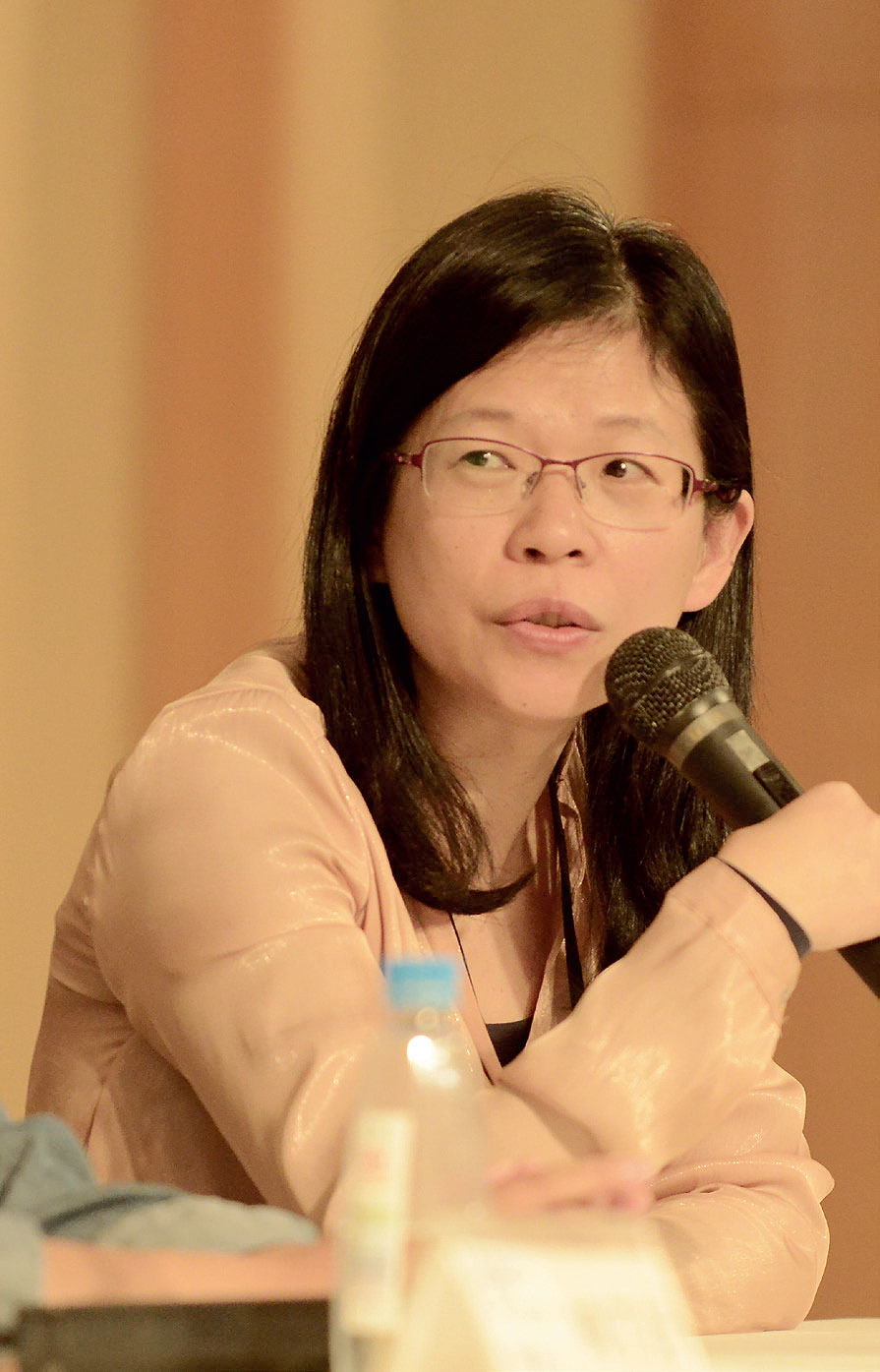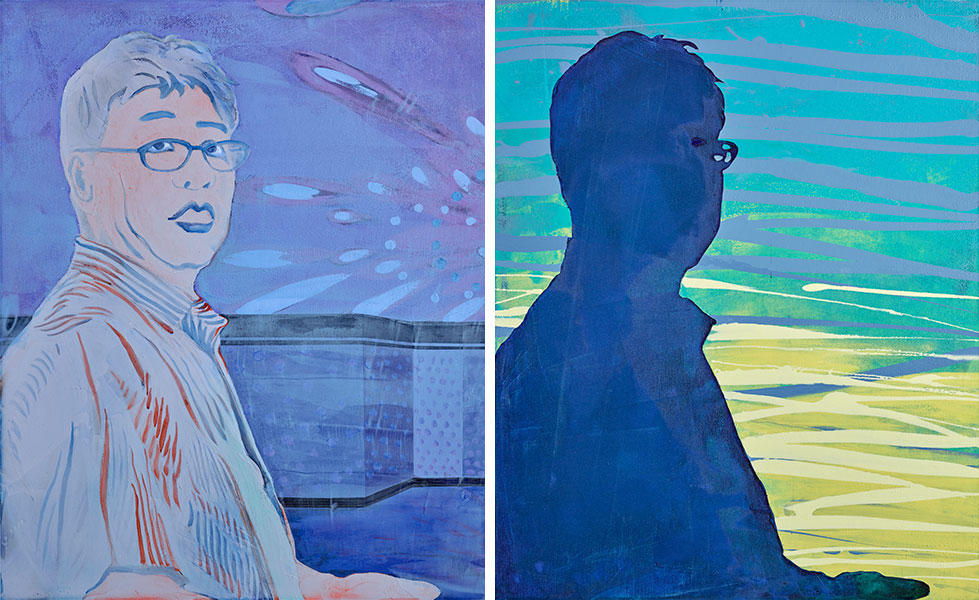Abserving Addiction – Kuei-Hua Lin’s Family Album

With tremendous energy and creativity, Kuei-Hua Lin always uses various materials and boldly attempts different methods without academic burden. In her exhibition in 2016, the series of huge and dazzling flowers express liveliness and unique technique and style. Although the flower series was unforgettable, Lin gave up flowers and landscape in her later creation. Without hesitation, she changed to figures painting.
Lin’s figure painting also comes from daily life, mainly about family, relatives, friends, especially family gathering and ordinary life. Le Portrait de famille, description of family and their lives, originated from the La Grande Bourgeoisie during the 19th centry Industrial Revolution. Comparing with the noble rank or priests, La Grande Bourgeoisie lack context of iconology from the past therefore change to praise values of family; they attempted to leave the image of their success in society and economy. During this period of time, photography was not popular yet. Family portraits are popular and play an important part in the modern paintings. Edgar Degas’s painting of his aunt and uncle , the“Bellelli” (1858-1867) was the most famous example. The painting consists great amount of details. It looks simple but it took Degas several years to finish. It always expresses his skill and cleverness in observing family relations. This painting also became his expression of realism and also showed the taste, style and attitude of the Bourgeois.
When photography becomes popular, with the transition of digitalized photograph, so called “ post-photo ”, family portraits have been replaced with family photos. It is no longer the Bourgeois’ possession. Family photos capture the very ordinary daily life activities. Family photo, in the contemporary images, stands a certain position. It not only valued by genealogists for building and filing family history data, it also is loved by contemporary artists, writers, photographers, screenwriters and movie lovers in 1960. People keep probing these private pictures, trying to dig out hidden stories behind the photos. Lin’s new works are obviously based on the family photos. Although she expresses it in paintings, the composition and framing are full of the touch of photography. It is interesting how reproducing the ordinary family photos in the expression of paintings can produce such refreshing result.
However, family photo is not that dull and ordinary in photography. Its ordinariness is also its uniqueness. Taking a family photo is to capture an important moment in family life(New Year, ceremony, vacation, etc.) and to keep it in the memories of the family members. Therefore, the figures postures, emotions, identification, the happening of incidents, etc. are better than the skill and presentation of photography. As photo capturer is usually not a professional, the unskillfulness becomes the trait and format of family photos. In other words, the will and choice of content of the capturer serves far more better than methodology. Moreover, family photo is not only an essential tool to explore the daily lives, it also serves as meaningful and unique images. When choosing the topic, the capturer especially loves the beautiful and joyful moments to beautify family’s common memory. These images bear the weigh of love and relations. Sometimes they are passed around within the family, individually sharing the private memory. Sometimes they are general, appropriate for everyone who holds similar memories and imaginations towards family. When they see other people’s family picture, they are also touched. Finally, people tend to systematically collect family pictures and arrange them in time, incident or other methods to create their own family album. Some artists prefer to use family photo album to structure and lay out their images. They choose and rearrange the images in their or other’s family photo album to “remise en scène”.

We can imagine Lin’s creation is also like this. She has a collection of family photo album, hers or collected. With the artist’s keen and wise sense, she chooses, connects and converts into paintings. Next, she arrange the works into a family photo album through exhibitions to start a story or description. Lin’s conversion of image to paintings is gorgeous. She prefers dazzling bright colors, but sometimes she uses silent and steady midtones. She likes linear framing and Silhouette-like thin and flat form. Sometimes she describes the portrait-ness and dimensionality. Sometimes the colors she uses follow the forms and shapes, but sometimes the jump out of the form and wildly spread on the canvas. Her colors are wildly spreading and dipping, some of them even protruding on the canvas like an embossment. However, sometimes her colors converge and hide, loyally serve the representation of paintings.
Such dynamic and complex techniques bluntly reemphasize its identity as a painting, hiding and balancing the origin of the used photo. She inadvertently cuts and captures reality like photo frames in the layout. As for the layout of figures and scenes, she purposefully emphasize the repetition, for example, “ Choice One”. “Choice Two” “Find One” “Find Two”, different method of copying of the same picture. She also prefers repetition of trivial difference in figure poses and different angles, such as the four pieces of works , “Enlightenment One” to “Enlightenment Four”, or the change in children’s poses “Wandering”and “Excited”, like continuous shooting. Moreover, the zoom in and zoom out of lens, such as “The Best Choice”is probably the close up of “Time Tunnel”, etc. These works all express their imagery, from family to portraits to the original family photos.
With these family photos, what kind of family album does Lin want to show us?
First of all, she is not in any of these pictures, implying she is an observer, narrator, photographer, collector or a portrait artist. Figures in the photos are mostly children, narrating a long history of the family. In the 19th century, only children with in a certain high ranking could be allowed in the photos. Nowadays, children have become the main figures in family photos. Nevertheless, when we look at these photos closely, it is surprising to see how they sharply reflect the current society. Intentionally or not, all of these works remind us of the existence of electronic devices such as cell phones, tablets, computers …etc. There is tremendous amount of screens appearing in the paintings. We can reasonably assume that these works originated from family photos taken by cell phones. Indeed, nowadays, taking family photos has become one of the main functions of cell phones. In 2007, when the first iPhone came out, Steve Jobs said, “Revolutionary product will change the world!” His prophecy has come try after 12 years. The world has been changed completely. According to the survey made by National Development Council in 2016, for people over 12 years old, three out of four people are cell phone holders. The time people spend online in one day is 3 hours and 21 minutes. There are 61% of people who eat and slide their cell phones when dining with their families and friends, 80% of people are waiting for a ride or in a ride, and 81% before they go to bed. Additions to electronics, computer/mobile games, cell nomophobia (fear of no cell phone), have become trendy vocabulary. We, as the slaves of cell phones, staring at the phone screens every now and then, checking social media every couple of minutes, replying and sharing instantly, have a hard time breathing. In Lin’s family photo album, seniors and children are constantly looking at the phone screens, sometimes alone, sometimes in a group watching videos or playing games. And the other family members indulge in the virtual world of mobile phones. Sometimes, they would take pictures of food tasting or karaoke. And next, of course, they would upload and check in on social media, back to phones. Wonderful moments such as gathering, eating and singing together stay in the family’s memory forever. However, the intentionally highlighted and flattened figures in photos lose their identification, like an emptied hold or a missing silhouette due to loss of memory.
What is Lin expressing through a family photo album like this?
I do not think she is simply criticizing the worried social phenomenon of additions to electronics. I am also not sure if she feels different, lost, or sorry that family is different today compared to the past. Her perspective is not quite clear. Especially when the identification of these family portraits are faded by her painting techniques, there is no evidence showing these photos originally belong to whom, to which particular family and their story. Just like Susan Sontag said,“ No matter whom is photographed, photos will convert to reality. The images of objects or incidents can be beautiful or scary, or unbearable, or tolerant even if they are not in reality.”With the interference of arrangement of images and the painting method, Lin presented a series of paintings that rely on the audience memory and imagination. However, no matter how realistically the audience can imagine, it is still someone else to them, therefore, they are still in the position of bystanders. Although in “ Regarding the Pain of Others”, Sontag refers to a more serious topic, the imagination family photo albums provide to the audience might be further than we can imagine.
These experience are very much like Christian Boltanski’s works. He rearranged the family photo album of one of his friends in 1971 and created“Album de photos de la famille D”. People thought they could find out the history of this family, however, Boltanski wrote,“ For the past 25 years of family life, we didn’t find anything. These images of family ceremonies send us to our own memories. In a percicular society, all family photo album share the simiar traits. They cannot reproduce reality, they only prsent the reality of the phto album.”As the function of family photo album alter as the society changes, especially in the post modern society, they tangle with history, society and politics files and become unclear, swinging in between virtuality and reality. Therefore, once family photos detach the original function and become anyonume, losing their referentinality, legality, date or a relevant name, they are left as reflective sumbols and memories. Lin’s every family portrait converted from family photo implies the passing of time, the change of the society, the conncection of history and the us at this very moment. I do not know why, but it reminds me of Rchard Hamilton’s famious work, “Just what is it that makes today’s homes so different, so appealing?”, in 1956.
